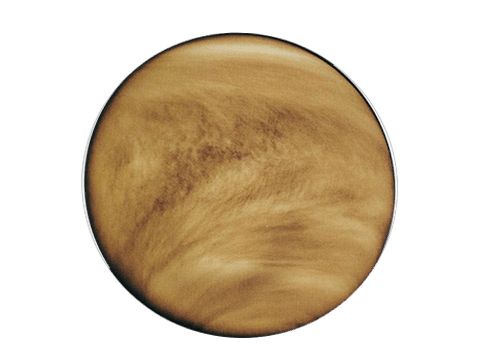Venus is the second planet from the Sun and the sixth-largest. Together with Mercury, they are the only planets without a satellite, even though Mercury is closer to the sun, Venus is the hottest planet.
Keys Facts & Summary
- Being very close to Earth, Venus was observed by ancient astronomers from different cultures many times however, the first accurate observation was in 1610 by Galileo Galilei.
- Galileo saw Venus through a telescope and determined it had phases similar to the Moon. This helped support the Copernican view that planets orbited the Sun and not vice versa as previously believed.
- Since Venus is the brightest object in the sky after the Moon, and the Sun, it was given the name of the Roman goddess of beauty and love, the ancient Greek’s named it Aphrodite.
- In ancient times, Venus was taught as being two different objects in the sky: The Mourning Star and The Evening Star. In Mercury’s case, it was also mistakenly believed to be two different things.
- It is the only planet named after a female deity and it is the brightest planet in the Solar System.
- When its surface was observed, it was determined that in fact its clouds were made up of sulfuric acid and water vapor, but more importantly, it’s temperature was measured, having an average of 465 degrees Celsius, 900 degrees Fahrenheit, hot enough to melt lead.
Venus
It isn’t possible to pinpoint the exact discovery date of Venus. Due to its brightness, it can be easily seen with the naked eye, meaning that any ancient civilization could be credited with the first observation. Copernicus, and later Galileo Galilei, are however credited with Venus’s classification as a planet while Mikhail Lomonosov has been credited with initially discovering the planet’s gaseous atmosphere in 1761. This claim was later verified in 1790 by astronomer Johann Schroter.
Though it has been visually observable for as long as mankind can remember, the naming of Venus is again a bit of a mystery. Venus received its most popular moniker via a selection of Roman gods and goddesses. Venus was named after the Roman goddess of love and beauty, a counterpart to Greek’s Aphrodite. It wasn’t always known as such. Ancient Babylonians who recognized Venus for example, named it as the Star of Ishtar, their own goddess of fertility, love and war.
To the Greeks, Venus was both Phosphorus and Hesperus and to the Romans, it was recognized as Lucifer and Vesper. Both nations didn’t know that the alleged two stars they were referencing was actually one body until later when further observations were conducted and its orbit was understood.
Formation
It is theorized that Venus was formed about 4.5 billion years ago when gravity pulled swirling gas and dust together to form the second planet and it later settled into its current layout.
Distance, Size and Mass
Venus is the second closest planet to the Sun, at a distance of 108.2 million km/ 67.24 mi or 0.7 AU receiving the sun’s light in 6 minutes. Venus has a radius of 6.051 km or 3.760 miles and a diameter of 12.104 km or 7.521 mi, slightly smaller than Earth.
Its closest approach to Earth happens once every 584 days, when the planets catch up to one another. On average it can get as close as 25 million miles or 40 million kilometers to Earth the equivalent of about 0.28 AU.
Orbit and Rotation
Venus orbits the Sun at an average distance of about 0.72 AU and completes an orbit every 224.7 days. Though most planetary orbits are elliptical, Venus’s orbit is the closest to circular with an eccentricity of less than 0.01. When Venus lies between Earth and the Sun in inferior conjunction, it makes the closest approach to Earth of any planet at a distance of 41 million km or 25 million miles. Venus spends most of its time away from Earth. This paradoxically makes Mercury the closest planet to Earth, a plurality of the time.
Picture of Planet Venus

Quick Facts
| Recorded By: | Babylonian astronomers |
| First Record: | 14th Century BC |
| Surface Temperature: | 462°C |
| Orbit Period: | 224.70 Earth days |
| Orbit Distance: | 108,209,475 km (0.73 AU) |
| Notable Moons: | None |
| Known Moons: | None |
| Equatorial Circumference: | 38,025 km |
| Polar Diameter: | 12,104 km |
| Equatorial Diameter: | 12,104 km |
| Mass: | 4,867,320,000,000,000 billion kg (0.815 x Earth) |











